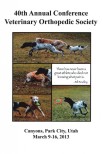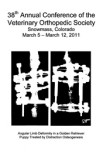Objectives The purpose was to compare the biomechanical properties of a 1.5 mm locking compression plate (1.5 LCP) to the 1.5 mm straight plate (1.5 P), 1.5 mm straight plate stacked (1.5 PSt) and 2.0 mm straight plate (2.0 P) in compression and torsion. We hypothesized that biomechanical properties of the 1.5 LCP would be equivalent to properties of the 1.5 P and would represent an alternative for the treatment of radial fractures in miniature breed dogs in which those plates would be used.
Materials and Methods A 1 mm fracture gap model was created with a bone surrogate stabilized with a six-hole plate. Sixteen constructs were built for each of the four plate configurations. Eight constructs from each group were tested in compression to failure and eight constructs were tested in torsion to failure.
Results In compression testing, the 1.5 LCP was stiffer than the 1.5 P, and had similar stiffness than the 1.5 PSt and the 2.0 P. The load at yield of the 1.5 LCP was slightly lower than the 1.5 P. In torsion, the 1.5 LCP and 1.5 P had similar stiffness, but 1.5 LCP was slightly stronger than 1.5 P. The 1.5 PSt and 2.0 P were overall superior to the 1.5 LCP but only marginally so for the 1.5 PSt.
Clinical Relevance The 1.5 LCP can be considered biomechanically equivalent to the 1.5 P under the present experimental conditions. The use of the 1.5 LCP can be considered as an option for radial fracture repair in dogs in which a 1.5 P would have otherwise been used. The use of a locking plate to improve overall success rate, in these fractures, remains to be confirmed clinically.









